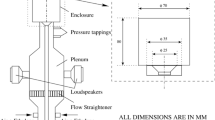Abstract
Three SGS stress closure LES models are evaluated for turbulent flow over a square cylinder. Emphasis is placed on solving engineering-application-type problems on affordable computer resources and within reasonable turnaround times. Results are compared with available experimental data and previously published workshop results. Numerical strategies are kept the same for all the cases. Results are also discussed keeping in view limitations of LES methodology of modelling for practical problems and current developments. It is concluded that a one-equation model for subgrid kinetic energy is the best choice.
Similar content being viewed by others
References
Deardorff J W 1970 A numerical study of three-dimensional turbulent channel flow at large Reynolds numbers.J. Fluid Mech. 41: 453–480
Davidson L, Peng S H 2003 Hybrid LES-RANS modelling: a one-equation SGS model combined with ak-ω model for predicting recirculating flows.Int. J. Numer. Methods Fluids 43: 1003–1018
Fureby C, Tabor G, Weller W G, Gosman A D 2000 A comparative study of subgrid scale models in homogeneous isotropic turbulence.Phys. Fluids 9: 1416–1429
Germano M, Piomelli U, Moin P, Cabot W H 1991 A dynamic subgrid scale eddy viscosity model.Phys. Fluids A3: 1760–1765
Horiuti K 1985 Large eddy simulation of turbulent channel flow by one-equation modelling.J. Phys. Soc. Jap. 54: 2855–2865
Leschziner M A 2002 At the crossroads of turbulence modelling and simulation: Opportunities and challenges.Advances in fluid modelling and turbulence measurements. (Singapore: World Scientific) pp 3–19
Lee B E 1975 The effects of turbulence on the surface field of a square prism.J. Fluid Mech. 69: 263–282
Lilly D K 1992 A proposed modification of the Germano subgrid-scale closure method.Phys. Fluids A4: 633–635
Lyn D A, Rodi W 1994 The flapping shear layer formed by flow separation from the forward corner of a square cylinder.J. Fluid Mech. 267: 353–376
Lyn D A, Einav S, Rodi W, Park J H 1995 A laser Doppler velocimetry study of ensemble-averaged characteristics of the turbulent flow near wake of a square cylinder.J. Fluid Mech. 304: 285–319
Moin P 1998 Numerical and physical issues in large eddy simulation of turbulent flows.JSME Int. J. B41: 454–463
Moin P, Mahesh K 1998 Direct numerical simulation — A tool in turbulence research.Annu. Rev. Fluid Mech. 30: 539–578
Morinishi Y, Vasilyev O V 2001 A recommended modification to the dynamic two-parameter mixed subgrid scale model for large eddy simulation of wall bounded turbulent flow.Phys. Fluids A13: 3400–3410
Nakayama A, Vengadesan S N 2002 On the influence of numerical schemes and subgrid-stress models on large eddy simulation of turbulent flow past a square cylinder.Int. J. Numer. Methods Fluids 38: 227–253
Nichols R H, Nelson C C 2003 Application of hybrid RANS/LES turbulence models.41st Aerospace Science Meetings and Exhibit, AIAA 2003-0083
Nitkin N V, Nicoud F, Wasistho B, Squires K D, Spalart P R 2000 An approach to wall modelling in large-eddy simulations.Phys. Fluids A12: 1760–1765
Ohtsuki H, Fujii K, Washizu H, Ohya A 1987 On the characteristics of three components of aerodynamic forces and pressure distribution around a fixed rectangular cylinder in a uniform flow.5th Symp. Wind Loads on Structures, pp. 169–175
Piomelli 1999 Large-eddy simulation: achievements and challenges.Prog. Aerosp. Sci. 35: 335–362
Rodi W, Ferziger J H, Breuer M, Pourquie M 1997 Status of large eddy simulation: Results of a Workshop.ASME J. Fluids Eng. 119: 248–262
Rodi W 1998 Large-eddy simulations of the flow past bluff bodies: State-of-the-art.JSME Int. J. B41: 361–374
Salvetti M, Banerjee S 1995 A priori tests of a new dynamic subgrid-scale model for finite difference large-eddy simulations.Phys. Fluids A7: 2831–2837
Smagorinsky J 1963 General circulation experiments with primitive equations -I, The basic experiment.Mon. Weather Rev. 91: 99–165
Spalart P R 1999 Strategies for turbulence modelling and simulations.Engineering turbulence modelling and experiments — 4 (New York: Elsevier Science)
Spalart P R, Allmaras S R 1992 A one-equation turbulence model for aerodynamic flows. AIAA Paper-92-0439
Strelets M 2001 Detached eddy-simulation of massively separated flows.39th Aerospace Sciences Meeting and Exhibit AIAA 2001-0879
Vreman B, Geurts B, Kuerten K 1997 Large-eddy simulation of turbulent mixing layer.J. Fluid Mech. 339: 357–390
Wilcox D C 2003Turbulence modelling for CFD 3rd edn. (Los Angeles, CA: DCW Industries)
Yoshizawa A, Horiuti K 1985 A statistically-derived subgrid-scale kinetic energy model for the large-eddy simulation of turbulent flows.J. Phys. Soc. Jap. 54: 2834–2839
Zang Y, Street R L, Koseff J R 1993 A dynamic mixed subgrid-scale model and its application to turbulent recirculating flows.Phys. Fluids A5: 3186–3196
Author information
Authors and Affiliations
Rights and permissions
About this article
Cite this article
Vengadesan, S., Nakayama, A. Evaluation of LES models for flow over bluff body from engineering application perspective. Sadhana 30, 11–20 (2005). https://doi.org/10.1007/BF02710076
Received:
Revised:
Issue Date:
DOI: https://doi.org/10.1007/BF02710076




